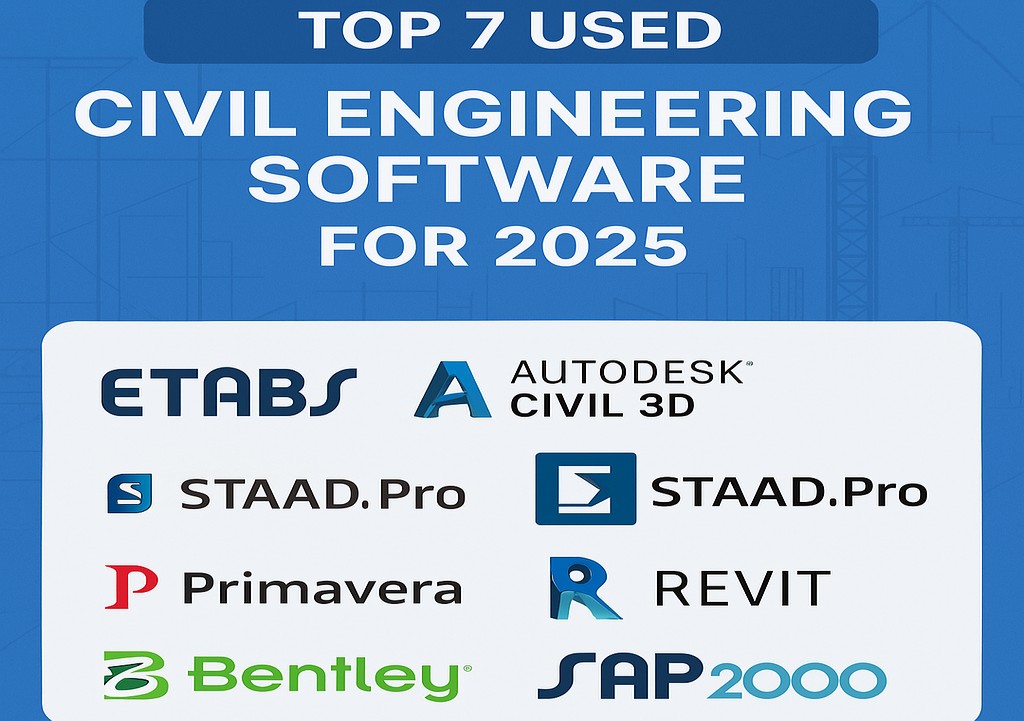Blog
Top 7 Must-Learn Civil Engineering Software in 2025

Civil engineering is a dynamic field that relies heavily on advanced software tools for design, analysis, and project management. As technology evolves, professionals must stay updated with the latest software to enhance efficiency, accuracy, and productivity.
In this blog post, we’ll explore the top 7 civil engineering software in 2025, their key features, usability, pros and cons, and why they are essential for every civil engineer. We’ll also provide purchase links for easy access.
1. AutoCAD Civil 3D
Description:
AutoCAD Civil 3D is a BIM (Building Information Modeling) software developed by Autodesk, specifically designed for civil engineers and surveyors. It is widely used for infrastructure design, land development, and transportation projects.
Usability:
- 3D Modeling & Design: Helps in creating detailed 3D models of roads, highways, and drainage systems.
- Surveying & Mapping: Supports point cloud data and GIS integration.
- Collaboration: Allows seamless teamwork with shared models and data.
Pros:
✔ Industry-standard software with extensive features.
✔ Excellent for grading, corridor modeling, and pipe networks.
✔ Strong integration with other Autodesk products (Revit, InfraWorks).
Cons:
✖ Steep learning curve for beginners.
✖ Expensive licensing model.
Why Learn in 2025?
AutoCAD Civil 3D remains a must-learn due to its dominance in civil infrastructure projects. Companies prefer engineers proficient in Civil 3D for large-scale developments.
🔗 Purchase Link: https://www.autodesk.com/products/civil-3d
2. Revit (for Structural Engineering)
Description:
Revit, another Autodesk product, is a BIM software used for structural design, MEP (Mechanical, Electrical, Plumbing), and architectural modeling.
Usability:
- Parametric Modeling: Allows real-time updates across all project views.
- Structural Analysis Integration: Works with Robot Structural Analysis and STAAD.Pro.
- Cloud Collaboration: Enables team coordination via BIM 360.
Pros:
✔ High precision in structural detailing.
✔ Seamless collaboration between architects and engineers.
✔ Supports 4D & 5D BIM (time and cost tracking).
Cons:
✖ Requires powerful hardware.
✖ Not ideal for non-BIM projects.
Why Learn in 2025?
With the global shift toward BIM, Revit expertise is highly sought after for sustainable and smart infrastructure projects.
🔗 Purchase Link: https://www.autodesk.com/products/revit
3. STAAD.Pro
Description:
STAAD.Pro by Bentley Systems is a structural analysis and design software used for bridges, towers, and industrial structures.
Usability:
- Finite Element Analysis (FEA): Supports static, dynamic, and nonlinear analysis.
- Multi-Material Design: Works with steel, concrete, timber, and aluminum.
- Code Compliance: Follows international standards (AISC, Eurocode, IS).
Pros:
✔ Powerful for complex structural simulations.
✔ Wide range of design codes supported.
✔ Integration with Revit and AutoCAD.
Cons:
✖ Expensive for small firms.
✖ Requires structural engineering expertise.
Why Learn in 2025?
STAAD.Pro is essential for structural engineers working on high-rise buildings and seismic-resistant designs.
🔗 Purchase Link: https://www.bentley.com/software/staad
4. ETABS
Description:
ETABS (Extended 3D Analysis of Building Systems) by CSI (Computers and Structures, Inc.) is a specialized software for building analysis and design.
Usability:
- Seismic & Wind Load Analysis: Critical for earthquake-prone regions.
- Shear Wall & Frame Design: Optimizes high-rise structures.
- Cloud-Based Collaboration: Works with SAP2000 and SAFE.
Pros:
✔ User-friendly interface for building modeling.
✔ Excellent for dynamic load analysis.
✔ Detailed report generation.
Cons:
✖ Limited to building structures (not for bridges).
✖ High computational power needed.
Why Learn in 2025?
With increasing skyscraper constructions, ETABS is a must-know for structural engineers.
🔗 Purchase Link: https://www.csiamerica.com/products/etabs
5. Primavera P6
Description:
Primavera P6 by Oracle is the leading project management software for construction scheduling and resource management.
Usability:
- Critical Path Method (CPM): Tracks project timelines efficiently.
- Resource Allocation: Manages labor, equipment, and budgets.
- Risk Analysis: Predicts delays and cost overruns.
Pros:
✔ Industry standard for large infrastructure projects.
✔ Excellent for handling multiple projects.
✔ Cloud and on-premise deployment options.
Cons:
✖ Complex for beginners.
✖ Expensive licensing.
Why Learn in 2025?
With mega construction projects worldwide, Primavera P6 skills are highly valued by employers.
🔗 Purchase Link: https://www.oracle.com/construction-engineering/primavera
6. HEC-RAS
Description:
HEC-RAS (Hydraulic Engineering Center – River Analysis System) by the US Army Corps of Engineers is used for flood modeling and hydraulic analysis.
Usability:
- 1D & 2D Flow Modeling: Simulates river hydraulics.
- Dam Break Analysis: Assesses flood risks.
- Free to Use: Government-funded software.
Pros:
✔ Free and widely used in water resource engineering.
✔ Accurate for floodplain mapping.
✔ Compatible with GIS tools.
Cons:
✖ Steep learning curve.
✖ Limited 3D visualization.
Why Learn in 2025?
With climate change increasing flood risks, HEC-RAS expertise is critical for sustainable water management.
🔗 Download Link: https://www.hec.usace.army.mil/software/hec-ras
7. SAP2000
Description:
SAP2000 by CSI is a general-purpose structural analysis software for bridges, dams, and industrial structures.
Usability:
- Linear & Nonlinear Analysis: Handles complex structural behaviors.
- Integrated Design: Follows international codes.
- Seismic & Dynamic Analysis: Essential for earthquake engineering.
Pros:
✔ Versatile for various structural types.
✔ Easy to learn compared to STAAD.Pro.
✔ Affordable for small firms.
Cons:
✖ Less advanced than ETABS for buildings.
✖ Limited BIM integration.
Why Learn in 2025?
SAP2000 remains a fundamental tool for structural engineers handling diverse projects.
🔗 Purchase Link: https://www.csiamerica.com/products/sap2000
Conclusion
Mastering these top 7 civil engineering software tools in 2025 will significantly boost your career prospects. Whether you’re into structural design, project management, or hydraulic modeling, these tools are industry standards that employers demand.
Invest time in learning them through online courses, certifications, and hands-on projects to stay ahead in the competitive civil engineering field.
